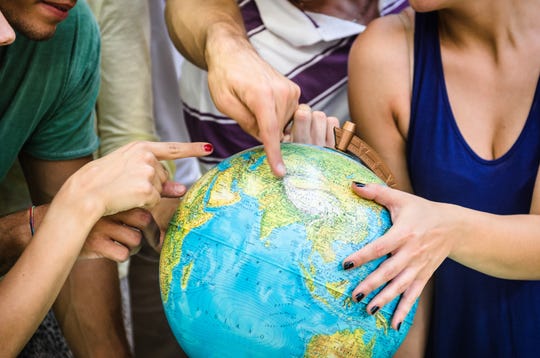The CDC has warned against traveling during the COVID-19 pandemic, but here are some ways to get you safely to new destinations.
USA TODAY
Here’s a trick question: Where’s the safest place to travel during the pandemic surge? Is it somewhere nearby? Or a squeaky-clean destination that takes its disinfecting really seriously?
You probably already know the answer is. It’s nowhere. The Centers for Disease Control and Prevention has warned against travel during the holiday season. And in a perfect world, people would stay home as the COVID-19 pandemic enters its most dangerous phase yet.
But we don’t live in a perfect world.
Picking a safe destination means first eliminating the most dangerous places – the ones with high COVID-19 infection rates. Then find the destinations where you’re least likely to sick. And then ask yourself: Can I afford to travel there?
How to find the safest place to travel during the pandemic surge

Picking a safe destination means first eliminating the most dangerous places — the ones with high COVID-19 infection rates. Then find the destinations where you’re least likely to sick. And then ask yourself: “Can I afford to travel there?” (Photo: franckreporter/Getty Images)
Some places are more dangerous than others. You can find information about your intended destination by consulting the following resources:
Which country has the most COVID-19 infections?
Where are the infection rates high? The Johns Hopkins University Coronavirus Resource Center is the go-to place for that information. It publishes a map of the United States and a world map showing you where the worst COVID-19 infections are. Avoid the dark-red areas.
What will the infection rates be when I travel?
The Institute for Health Metrics and Evaluation, a research center at the University of Washington, predicts infection rates. You can get a pretty good idea of whether infection rates will go up or down by studying the institute’s charts. U.S. infections will be trending higher in the next few months, the institute predicts.
Which destinations are taking COVID-19 seriously?
One way to determine that is by seeing if it displays the World Travel & Tourism Council’s Safe Travels stamp to assure the destination is doing everything it can to contain the virus. Among the countries adopting these health and hygiene protocols: Croatia, Portugal, Jamaica and Bermuda.
Are remote destinations safer during the pandemic surge?
Is traveling far away from civilization the best way to avoid a COVID-19 infection? Maybe, maybe not. Talk to tourism insiders who are in remote locations, and they’ll tell you that there’s a little more to it.
“The safest places to stay are standalone units like cabins and cottages with outside entrances,” says Lynda Paquette, a manager at Angels Rest on Resurrection Bay, a resort near Seward, Alaska. “If those units are also equipped with good air filtration, including UV-C filtration, that’s a bonus. A self-check-in and self-check-out policy make those processes safest.”
The CDC just sliced the recommended quarantine time in half for some cases of exposure to COVID-19.
USA TODAY
If you try to get out of town, it doesn’t mean you let your guard down about safety precautions and personal responsibility, say other tourism experts. Respect the communities you are visiting and be mindful of the safety protocols in place, says Liz Bowling, a spokeswoman for North Lake Tahoe in California.
“Consistency is key,” she says. “Many destinations have created graphics, signage and advocacy campaigns to communicate mask requirements, safe travel tips and simple reminders about the importance of caring for public lands.”
North Lake Tahoe also has a Know Before You Go initiative to inform visitors of its precautions. It shares a guide, videos and sample itineraries on its social media channels to help assure guests that businesses in North Lake Tahoe “are working hard to stay safe and open,” says Bowling.
Looking for the safest place to travel? Your behavior matters
But experts say no destination can assure your safety during the second wave. It’s what you do at the destination that makes a difference.
Marisa DeSalvio, a travel adviser from Washington, D.C., tells her clients to avoid places with high community transmission rates and COVID-19 positivity rates. She tells her customers to look for clear health guidelines and frequent testing. But they can still travel to those places safely if they take the proper precautions.
“Any location can be safe as long as the travelers themselves and the community they are visiting follow the correct behavior of recommended health guidelines,” she adds.
That’s reasonable advice. Some destinations are more dangerous than others. But it’s what you do in those places that matter more than anything.
Practice safe travel during the holidays. Better yet, wait until the vaccine is available before going anywhere.
Mask minefield: What to do if your travel seatmate flouts the rules and won’t mask up
Tips for finding the safest places to travel during the pandemic surge
Get advice from someone who’s there. “One of the best things you can do is find a local whose opinion you trust,” says Erin Clarkson, author of the “Savannah First-Timer’s Guide.” If you don’t know anyone, try looking online or connecting with a local on social media. Clarkson runs a private Facebook group where first-time visitors can ask questions about Savannah, Georgia, for example.
Stay away from crowds. Unless you’re in a bubble, a crowd is dangerous. “Outdoors is better than indoors,” says Global Rescue CEO Dan Richards. “Solo trips or small group adventures with people in your bubble are best. Remote is better than urban.”
Don’t forget your escape plan. “Travel is inherently risky during a pandemic,” says Ben Carothers, a flight coordinator at Global Air Ambulance. “But a safe destination, in my opinion, is one where it’s easy to return home in case of emergency or illness.” In other words, if you go for a remote place, make sure it’s not too remote. If you get sick, you might not have an easy way home.
Read or Share this story: https://www.usatoday.com/story/travel/advice/2020/12/11/traveling-during-covid-19-heres-how-pick-safe-destination/6506872002/

